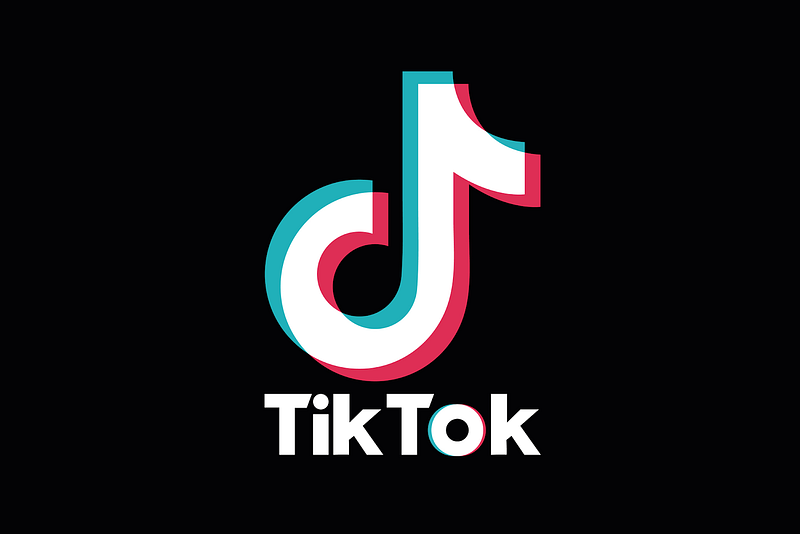TikTok: A Global Sensation
TikTok is one of the fastest-growing social media platforms in the world. Since its international release almost four years ago, TikTok has…
TikTok is one of the fastest-growing social media platforms in the world. Since its international release almost four years ago, TikTok has grown especially popular amongst the Gen-Z and millennial demographic. With nearly 690 million monthly active users in 155 different countries, it is now the seventh-largest platform in terms of users, beating some of its older rivals like Snapchat, Twitter and Pinterest.
No digital platform is perfect. As popular and well-loved TikTok is, it has also faced a lot of criticism, ranging from the sexualisation of children to the toxic environment within the app. So in this article, I’d like to explore this very debacle, the pros and problems with TikTok.
Pros of TikTok
1. It’s easy to go viral
It’s easier to go viral on TikTok, as compared to other platforms like YouTube or Instagram because most Tiktok users tend to scroll through their “For You” page, where they are recommended content from all over the world based on the location or what the algorithm thinks they’ll like. This means that the content users’ recommendations are not restricted to just who they follow. TikTok users can utilise soundtracks, audios and hashtags when creating and sharing their videos. If they use hashtags or audios that are in trend, their TikTok is more likely to be recommended and viewed by a larger audience.
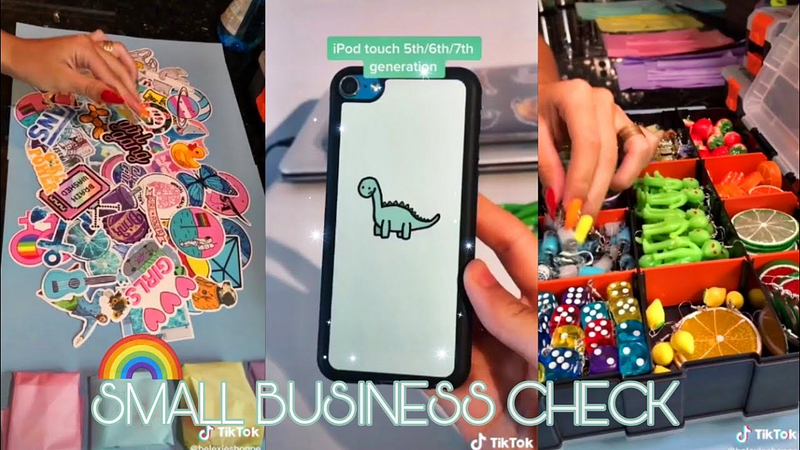
52% of users say they discover new products on TikTok. Small businesses can also gain traction for their products and services by sharing about them and advertising themselves on the app. Lesser-known artists can use TikTok to share their music and gain popularity. Some artists, like J.Maya who wrote Achilles Heel, even launched their music careers because of TikTok. Through a few clicks, we can support these small businesses and artists.
The idea of being famous, even if it’s just for a moment of five-second fame, can be exciting for many. Even if you’re not an artist running a small business, TikTok’s design still makes it easier to gain a larger following overnight compared to other apps, helping you expand your platform.
2. Entertaining and educational
TikToks are engaging, fun and specifically catered to suit your taste and preferences, so it’s no wonder that people love it so much. Trends in particular are very prevalent on the app. There are dance challenges, makeup trends, fashion trends, anime trends, food trends etc. There are sides of TikTok that cater towards all sorts of niches and interests.
TikTok can be educational as well. There’s this hashtag called #learntok where users can learn about all sorts of content. There are TikTok accounts that share about science, law, and economics, provide tips on how to manage stress, or even tips on improving your workout routine. There are TikTok accounts owned by zoos who teach you about animals. There are investors that share their insights on stock and trading. There are even fashion or makeup gurus that share how to draw your eyeliner or dress in a certain aesthetic. As TikToks are generally engaging and are only a maximum of a minute long, it can be a very digestible and easy way to learn more.

During an unprecedented time like this where the world is under lockdown due to the pandemic, apps such as TikTok can help bring a smile to our faces and distract us from the modern frenzies of our world. It’s a good way to destress and perhaps even help us cope when we’re feeling down. It can also keep us entertained and or well-informed if we’re ever feeling bored.
3. Can be used to raise awareness of ongoing movements and real world problems
Using a platform like TikTok is a great way to spread awareness. It exposes us to news that some of us perhaps wouldn’t have seen otherwise. TikTok has been used to spread awareness on ongoing issues like racism and climate change, movements like BlackLivesMatter and AsianLivesMatter, as well as international fights for democracy including the Hong Kong protest and the Myanmar protest.
Teens and young adults have used TikTok to raise awareness for Uighur Muslims locked up in Xinjiang, China. One TikTok posted by a previously unknown user, Feroza Aziz, started off with her curling her eyelashes. The video seems to be about beauty tips at first, but then quickly transitions into an educational video about the Xinjiang re-education camps. Some people who were not previously aware of this issue then commented on her video, thanking her for posting about it. TikTok, owned by the Beijing-based company Bytedance, has taken down the video due to the content’s political sensitivities. Nonetheless, the TikTok video has since been reposted on several websites.
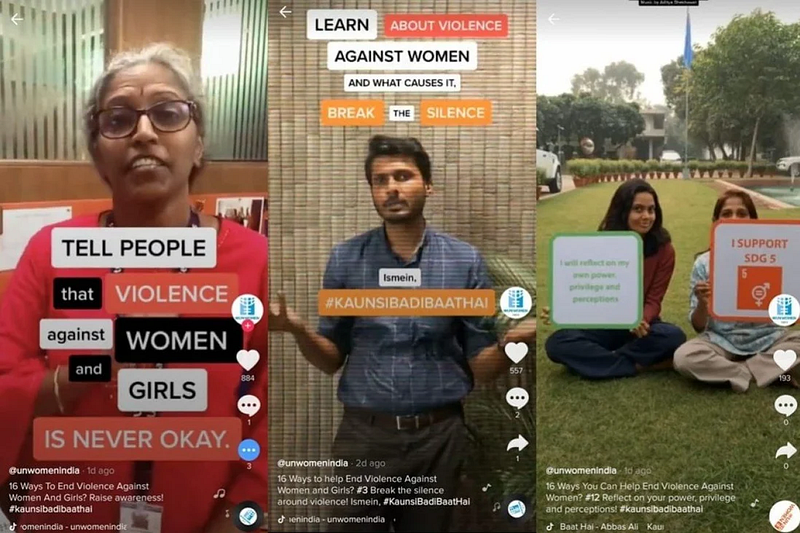
As part of a larger initative by UNWomen that marks 16 days of activism against gender-based violence, UNWomen India collaborated with TikTok to raise awareness about violence against women in India by lauching the #KaunsiBadiBaatHai campaign. The in-app campaign aimed to encourage users to show their support by undertaking the #KaunsiBadiBaatHai ‘Rap for Change’ challenge and by sporting shades of orange in their videos. The campaign rap known as Kaunsi Badi Baat Hai highlighted instances of violence against women and questioned existing negative socio-cultural norms. The hashtag was run for 16 days to mobilise TikTok users from across the country to participate.
While some might make satirical TikTok videos as a form of coping mechanism for themselves and others, it is videos like these and others that help us educate each other and encourage one another to research the situations at hand to find out more about what’s going on around us.
4. Promote positive messages and self-love
There has been a rise of TikTok trends spreading messages of self-love, body positivity and acceptance. As the narrative of our civilisation changes into one that is more inclusive, one that emphasizes the importance of embracing ourselves as well as our flaws, so does the narrative of the trends that arise on popular digital platforms like TikTok. In fact, one might even say that it is the impact of these social media trends have had on our perceptions and beliefs that has led to, or at least accelerated, the change in society’s narrative on what self-love or beauty truly means.
TikTokers that produce content promoting body positivity such as Sienna Gomez and Ambar Driscoll help to break beauty standards and redefine what it means to be beautiful. When bodies of different shapes and sizes are shown on mainstream platforms like TikTok, when people, young or old, see others with similar body types embrace and love their bodies, it can encourage them to love their own too. For people who might perceive certain aspects of their body, like perhaps their cellulite, stretch marks or hair to be “flaws” or “imperfections”, seeing others who too have those same “imperfections” embrace them and love their bodies the same regardless might help them change their views and better appreciate every part of their body.
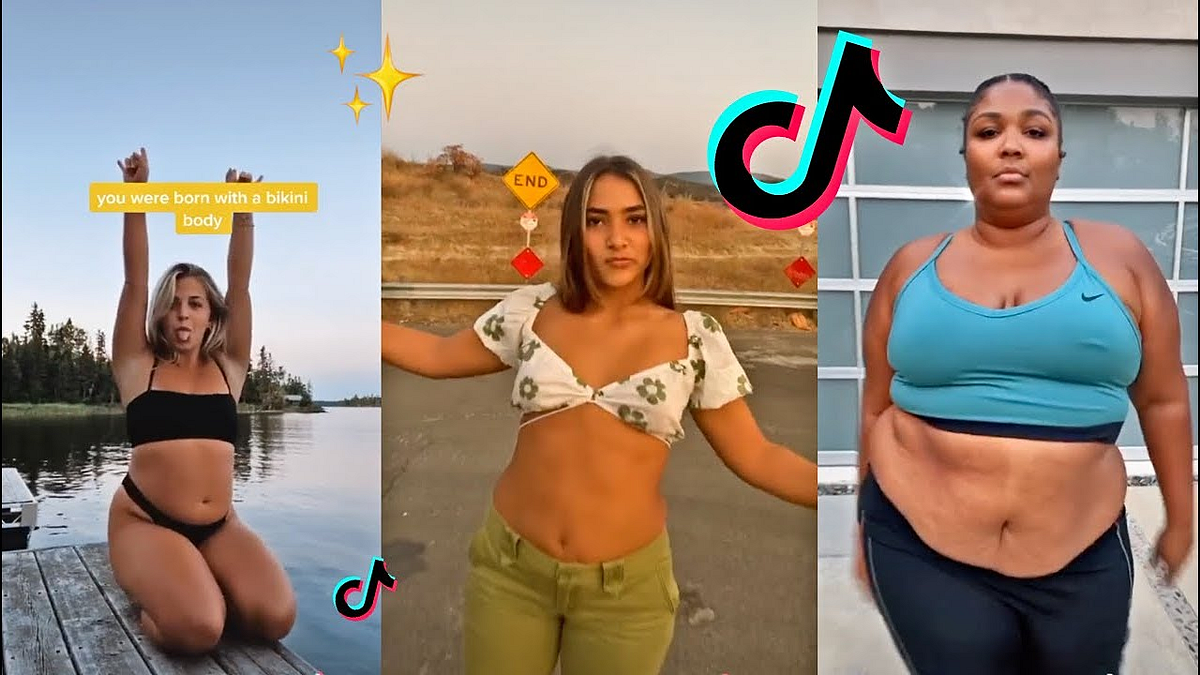
When people hear messages of self-love and acceptance on TikTok, like it’s okay not to be perfect or to feel like you don’t have your life together, and that they’re not alone, it can really provide a sense of comfort to the user and help take them a step closer to self-acceptance. For someone who might be a bit too hard on themselves, struggling to appreciate themselves or who might be feeling stressed because of work or school, hearing someone tell them that everything will be okay, that they will be alright and that the feelings will pass can really help relieve them from some of their stress or burdens.
The positive messages and content shared can help lift others up, opening them to a new perspective or give them a new mindset to chew on. This could help steer some people towards a path of deeper self-love, growth and acceptance.
Problems with TikTok
1. It’s addictive
Social media is engineered to be addictive in general to increase the time we spend on the apps. However, the TikTok algorithm and user interface brings this to a whole new level.
Simplicity is the core of TikTok. Bytedance, TikTok’s parent company, has designed the user interface to be very slick and easy to navigate through. TikTok’s algorithm is powerful and does a brilliant job at recommending relevant content that keeps its users hooked. They take into account the time you spent watching a particular video, how you interacted with it and then use that information to fill your feed with more videos you would like to watch. With very little interaction, the TikTok algorithm is able to generate an interesting feed. Unlike other social media sites like Instagram and Twitter that refresh their feed, the TikTok feed is bottomless as most users spend their time on the For You page and thus is not reliant on who or how many people you follow. The For You page doesn’t show you the time either, so you can just keep scrolling and swiping to look for interesting stuff infinitely without knowing how much time has passed, making it a lot easier to fall prey to wasting hours and hours on the app.
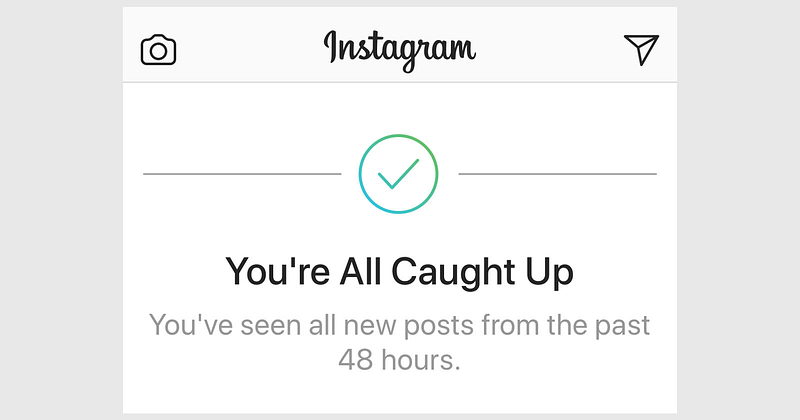
TikTok uses lots of behavioural psychology principles to become the app that users keep coming back to. The simplicity of the interaction and focus on the recommendation of content interesting and relevant to the user fuses together and forms a wonderful strategy of how to hook their users. TikTok incorporates the same principle used in slot machines — variable rewards — creating a powerful technique that makes TikTok so addictive. Users don’t know what video they’ll be recommended next, whether it be a funny video or an interesting trend, so they keep swiping their feed, eager to find out. Instagram was doing the same thing until they added a “You’re all caught up” message to break this loop and give users a way to stop the interaction.
All these features make TikTok’s design very addictive, perhaps even more so when compared to other social media apps. If you are a TikTok user, just make sure you’re aware of how much time is passing so you don’t end up spending 20 hours on the app.
2. The dangers of child predators
Experts warned that the biggest cybersecurity threat on the platform is TikTok’s troubling disregard towards cyber safety. A recent investigation found that there are children as young as eight being groomed on TikTok. Many young users on TikTok are bombarded with explicit messages as well.
TikTok’s community guidelines forbids users from harassing underage users using public posts or private messages, claiming that if the company becomes “aware of content that sexually exploits, targets, or endangers children”, it may “alert law enforcement or report cases”.

According to the investigation conducted by BBC News, hundreds of sexually explicit comments have been found on videos posted by children as young as nine. While many users hide behind anonymous profiles when sending these disturbing messages, others use what appears to be their real names and photos, uploading their own content onto the app. TikTok deletes most of the comments when they are reported but despite the platform’s rules against sexual messages directed at children, most users who posted the comments were still allowed to remain on the platform. There were still a number of inappropriate messages that TikTok still failed to remove. Although BBC’s investigation focused on sexually explicit comments, they also found instances where children were sent violent or threatening messages.
Liz W., an 18-year-old activist trying to stop this issue, talked about the disadvantages of TikTok’s features with Buzzfeed News. She said,
“If some creepy guy just keeps liking videos of younger girls doing similar audios or soundtracks or hashtags, those are going to keep coming up on his ‘For You’ page, so it’s easier for him to find more victims. And I think that’s what makes it so easy for predators to come on it and victimize young children.”
3. Sexualisation of underaged teenagers and children
According to The Sun, thousands of young teenagers are posting sexualised content on TikTok, exposing themselves to millions of people. Explicit videos including underaged teens detailing their sexual experiences or talking about desiring their teachers in an inappropriate manner has been raising a lot of concern.
The Sun says that while some of the content shared may seem harmless when shared between friends, many of these videos are public and accessible to anyone on the app. Combined with the problem above, the existence of online predators, this becomes an even bigger issue.
In the US, the National Center on Sexual Exploitation (NCOSE) listed TikTok on its 2020 ‘Dirty Dozen’ list, a list of mainstream companies that facilitate sexual exploitation.
Haley McNamara, Vice President of Advocacy and Outreach at NCOSE, says,
“All kinds of social media can be used to sexually groom or harm or traffic children or adults, but TikTok is particularly ineffective at creating a safe online space.”
Dr Elaine Kasket (Source: University of Wolverhampton)
Dr Elaine Kasket, a psychologist who has extensively researched social media, says TikTok’s system artificially amplifies a natural phenomenon. She says that teenagers are naturally interested in taking risks and in discovering and exploring their sexuality. They are open to flattery, seduction and the verification they get from the hearts and likes their videos receive. Dr Kasket says that when we combine an adolescent’s desire for approval with a global digital platform, it can massively increase encouragement for teenagers to post sexual content.
However, she also warns that many children might not want to speak with their parents about their sexual experiences online, often because they are worried that their parents are going to be hard on them in a shaming way when they find out their kids have been doing something sexualised on the Internet. According to Dr Kasket, the way social media platforms function makes certain types of videos spread more easily. She says that if TikTok puts in more controls that make it less possible for sexualised content to be available on the platform, TikTok might be undermining their company’s profit to a certain extent as it is probably one of the reasons why the platform is popular among a certain demographic.
A spokesperson from TikTok announced a new feature that allows parents to control what their kids view, stating clearly that they do not tolerate predatory or grooming behaviour towards minors and that their moderators will work around the clock to review content and ban accounts that violate their policies. TikTok encourages the community to report anyone that is using TikTok inappropriately and that the reports will be analysed by an expert review team who will take action in line with their Community Guidelines and Terms of Service. TikTok also says that they will continue to strengthen their moderation policies and processes.
4. Can be used to spread hate and misinformation
According to a recent investigation carried out by media group, Media Matters for America, TikTok’s account recommendation algorithm has seemingly been prompting users to follow far-right extremist movements. These far-right extremist accounts include Three Percenter, QAnon, Patriot Party, and Oath Keeper accounts, far-right movements that were heavily involved in the planning and execution of the Capitol riot that took place on January 6, a violent riot that resulted in five deaths and nearly 140 injuries to the police who defended the Capitol. These accounts were also involved with spreading misinformation about the covid-19 vaccines.
The content of these far-right movements are prohibited by TikTok but the TikTok algorithm is still both circulating their content and helping them to expand their following. Tiktok told the media that the platform works very efficiently to stop the spread of any type of misinformation and violence, claiming that it has banned such accounts and its followers from the social media app. However, the investigation conducted by Media Matters for America tells us otherwise.

Media Matters’s analysis found that by following TikTok’s suggested follower prompts, users can easily be exposed to and be increasingly recommended far-right extremist accounts and content. This can be very harmful as it could potentially further radicalize people interested in these movements and it doesn’t even require users to seek them out. This accelerated pattern of recommendations is alarming and could potentially push TikTok users down a far-right rabbit hole, which could further populate user feeds with misinformation and hate content that accounts supporting these movements spread to their followers.
“TikTok hand-delivers the extremist movements to its users, many of whom are 14 or younger.”
— Media Matters for America”
TikTok intends to improve their policies and actions towards hateful content and behaviour with the aim of eliminating hate on the platform. They have already banned explicitly hateful ideologies such as neo-nazism and white supremacy, as well as related ideologies like white nationalism and white genocide theory.
According to sources from August 2020, TikTok says it uses a range of measures to both detect and limit the spread of hate speech, including re-directing people who search for offensive content. However, considering the fact that the Media Matters report on TikTok was released in late March 2021, a very recent report that highlighted TikTok’s mishandling of the very issue, TikTok may be more bark than bite.
TikTok is responsible for improving their policies regarding hate speech and misinformation, and we should hold them accountable for it. We will never be able to completely eliminate hate speech or misinformation from a platform but it is reasonable to expect such content to be dealt with very quickly and efficiently for the wellbeing and safety of the general public.
In the end, TikTok is just a tool at our disposal. It is up to us on what, how and for how long we use it. Yes, TikTok is addictive, but it is also an entertaining and wonderful way to relax after a long day. Yes, it is possible to spend countless hours blindly scrolling through the app, but if we remain aware of how much time is passing and limit the time we spend, it’s okay to just have fun with the app.
If you see a TikTok video you don’t like or that it raises some concerns, just let the algorithm know and you will not be recommended with those videos anymore. Be careful and follow standard internet safety rules, don’t post anything publicly that you’re not comfortable with the whole world seeing. If you do see a video that you like, interact with it positively and you’ll see more like it! You control your feed.
“TikTok, like many other social media platforms, can be a dangerous place where misinformation and hate can spread. However, TikTok can be a beautiful place where positive messages of acceptance and hope can be shared too.”
TikTok is a tool, a powerful tool, so make sure to use it wisely.
[Written by: Ruby Seet]
References
Teens, young adults are using TikTok to raise awareness for Uighur Muslims
TikTok teams up with UN Women to raise awareness about violence against women in India
TikTok is seen to be prompting accounts that circulate hate and misinformation
TikTok is prompting users to follow far-right extremist accounts
TikTok Provides an Update on its Approach to Hate Speech and Offensive Content


